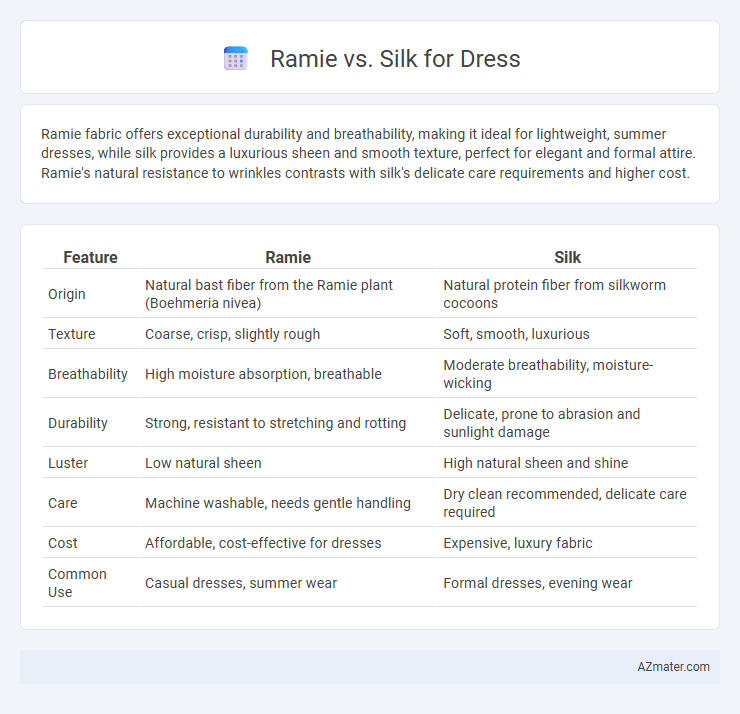Ramie fabric offers exceptional durability and breathability, making it ideal for lightweight, summer dresses, while silk provides a luxurious sheen and smooth texture, perfect for elegant and formal attire. Ramie's natural resistance to wrinkles contrasts with silk's delicate care requirements and higher cost.
Table of Comparison
| Feature | Ramie | Silk |
|---|---|---|
| Origin | Natural bast fiber from the Ramie plant (Boehmeria nivea) | Natural protein fiber from silkworm cocoons |
| Texture | Coarse, crisp, slightly rough | Soft, smooth, luxurious |
| Breathability | High moisture absorption, breathable | Moderate breathability, moisture-wicking |
| Durability | Strong, resistant to stretching and rotting | Delicate, prone to abrasion and sunlight damage |
| Luster | Low natural sheen | High natural sheen and shine |
| Care | Machine washable, needs gentle handling | Dry clean recommended, delicate care required |
| Cost | Affordable, cost-effective for dresses | Expensive, luxury fabric |
| Common Use | Casual dresses, summer wear | Formal dresses, evening wear |
Introduction to Ramie and Silk Fabrics
Ramie fabric, derived from the stalks of the Chinese nettle plant, is known for its durability, breathability, and natural luster, making it an eco-friendly choice for dress materials. Silk, a protein fiber produced by silkworms, is prized for its smooth texture, luxurious sheen, and excellent drape, often associated with high-end fashion and formal wear. Both fabrics offer unique qualities: ramie provides a more textured, matte appearance suitable for casual and summer dresses, while silk offers elegance and softness ideal for sophisticated and evening garments.
Origins and Production Processes
Ramie is a natural fiber derived from the stalks of the flowering plant Boehmeria nivea, primarily cultivated in China and the Philippines, requiring labor-intensive harvesting and degumming to extract the fibers. Silk originates from the cocoons of the Bombyx mori silkworm, mainly produced in China and India, involving a delicate reeling process to obtain fine, continuous filaments. The production of ramie emphasizes mechanical and chemical treatments to soften the fibers, whereas silk production relies on sericulture and careful unraveling techniques to preserve its smooth texture.
Texture and Appearance Comparison
Ramie fabric offers a crisp, rough texture with a natural luster that enhances its slightly glossy appearance, making it suitable for summer dresses with a structured look. Silk, on the other hand, boasts a smooth, soft texture and an elegant sheen that creates a luxurious and flowing appearance, often preferred for formal or evening dresses. The tactile contrast between Ramie's coarse firmness and Silk's delicate softness directly influences dress silhouettes and the drape of the garment.
Durability and Longevity
Ramie fabric offers exceptional durability due to its natural resistance to wear and high tensile strength, making it an ideal choice for dresses intended for long-term use. Silk, while luxurious and smooth, is more delicate and prone to abrasion and environmental damage, which can reduce the garment's longevity if not carefully maintained. Choosing ramie over silk for dresses ensures enhanced durability and longer lifespan, especially in everyday or high-activity wear scenarios.
Comfort and Breathability
Ramie fabric offers excellent breathability and moisture-wicking properties, making it ideal for hot and humid weather, while silk provides a smooth, luxurious feel with natural temperature regulation that keeps the wearer comfortable in varying climates. Ramie's coarse fibers contribute to durability and airflow but may feel rough against sensitive skin compared to the soft, hypoallergenic texture of silk. Both textiles excel in comfort, with ramie best suited for casual, breathable dresses and silk favored for elegant, lightweight garments.
Environmental Impact and Sustainability
Ramie fabric, derived from the nettle plant, offers a highly sustainable alternative to silk, as it requires minimal pesticides and water during cultivation, reducing environmental impact significantly. Silk production involves energy-intensive processes and often raises ethical concerns due to silkworm harvesting, contributing to higher ecological footprints. Choosing ramie for dresses supports eco-friendly fashion by promoting biodegradable, renewable fibers with a lower carbon footprint compared to traditional silk.
Care and Maintenance Requirements
Ramie fabric requires gentle hand washing with mild detergent to maintain its strength and texture, avoiding bleach and excessive heat that can cause fiber damage. Silk demands delicate care, including dry cleaning or hand washing with cold water and specialized silk detergent to preserve its natural sheen and prevent shrinking or color fading. Both materials should be air-dried away from direct sunlight and ironed on low heat settings to extend garment longevity.
Cost and Accessibility
Ramie fabric is significantly more affordable than silk, making it a cost-effective choice for dressmakers on a budget. Ramie is widely accessible due to its cultivation in various regions and less intensive production process, while silk remains a luxury fiber primarily sourced from specialized silk farms. The availability of ramie enhances its practicality for everyday dresses, whereas silk's higher cost and limited supply position it as a premium option for special occasions.
Best Uses in Dressmaking
Ramie fabric excels in summer dresses due to its lightweight, breathable, and moisture-wicking properties, making it ideal for casual and semi-formal wear. Silk offers a luxurious sheen, smooth texture, and excellent drape, perfect for elegant evening gowns and formal dresses that require fluid movement and a refined finish. Both materials can be blended or chosen based on the dress's intended use, balancing durability and comfort with sophistication.
Choosing Between Ramie and Silk for Dresses
Ramie fabric offers exceptional durability and moisture-wicking properties, making it ideal for breathable, lightweight summer dresses that require a natural, linen-like texture. Silk provides luxurious softness and a lustrous finish, perfect for elegant dresses that prioritize smooth drape and a premium appearance. When choosing between ramie and silk for dresses, consider factors such as comfort, fabric care, environmental impact, and the dress's intended use to determine the best textile for your wardrobe needs.

Infographic: Ramie vs Silk for Dress
 azmater.com
azmater.com